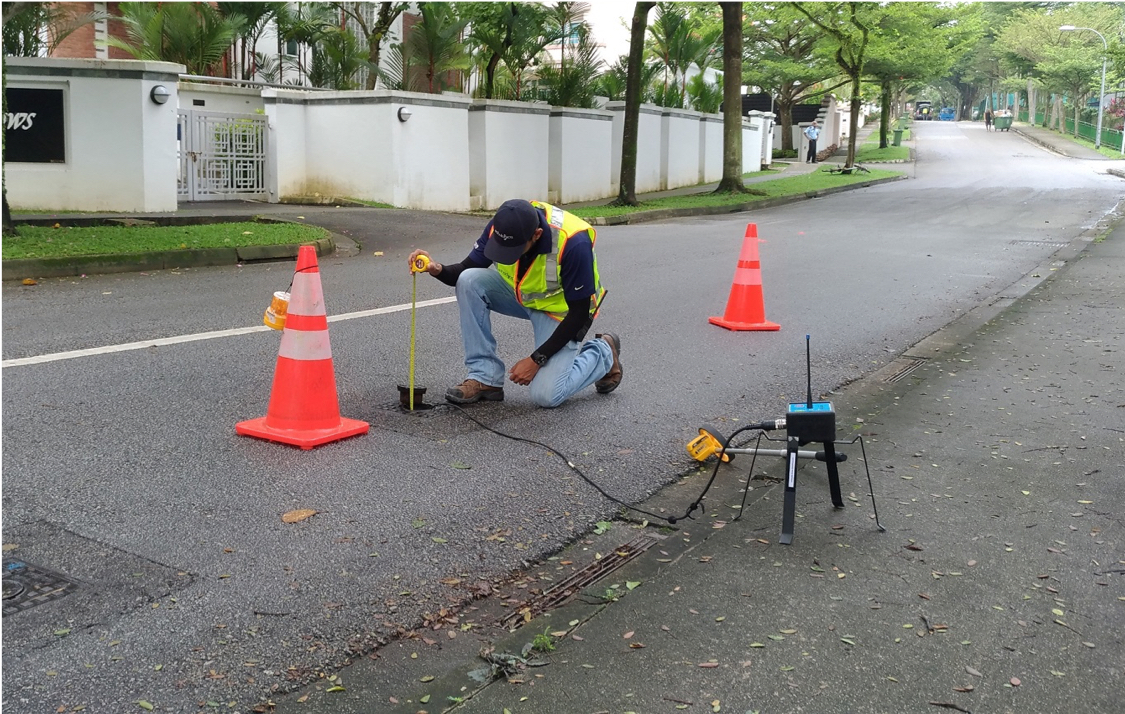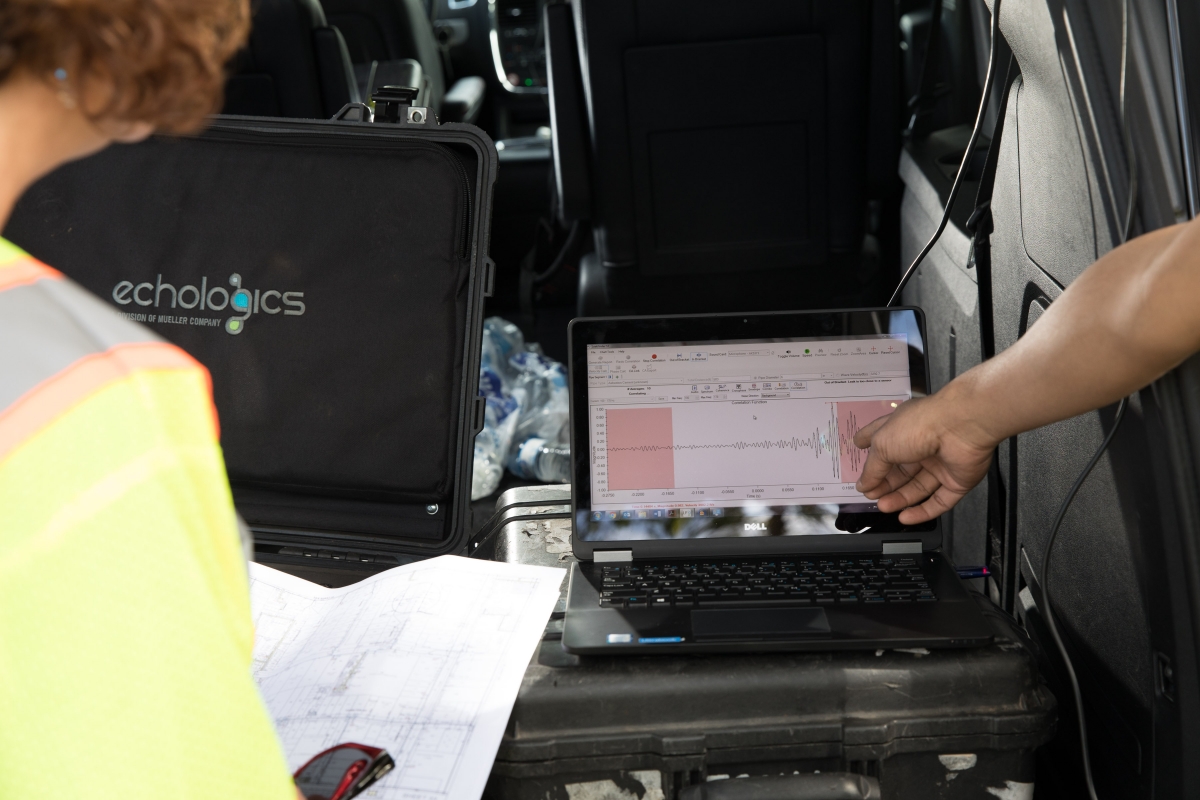TECH FOCUS
AUTOMATION, SOFTWARE, LEAKAGE DETECTION
This article focusses on two cost-effective approaches that help utilities to get ahandle on Non-Revenue Water (NRW) quickly and effectively.
By Martin Topps
EVERY WATER UTILITY has some degree of leakage or water loss within their water distribution system which, when understood, can be dealt within many ways. Despite this, excessive water loss has con-tinued to grow, as aging infrastructures further deteriorateoften due to a lack of funding for rehabilitation. As populations increase, new customer demand increases the stress on the already overloaded pipe networks and the problem compounds. This article focusses on two cost-effective approaches that help utilities to get a handle on non-revenue water (NRW)quickly and effectively.
Leakage Detection and Condition Assessment
A sound approach in reviewing water loss reductions hould include a leak detection and condition assessment plan. Echologics technology, a Mueller Water Products brand, non-invasively detects under-ground leaks and assesses the condition of water mains without disrupting service or inserting anything into the pipe system. This is achieved using acoustic sensors attached to existing components such as fire hydrants, valves or directly in contact with a pipe. These sensors listen for the sound that a leak creates, and correlate the position of the leak. With condition assessment, a sound wave is induced in thepipeline and acoustic sensors capture data that is analyzed using proprietary algorithms to assess the integrity of pipelines.
Implementation of an Echologics leak detection or condition assessment program typically starts with a proof-of-concept pilot project to document success and determine potential return on investment(ROI). Before laying out a pilot program, it is important for the supplier and customer to agree upon the concept being tested, the capital costs, the relative cost of services, and the criteria on which the performance is going to be evaluated. Evaluation criteria can range from the simplicity of system installation to supporting software features and the ease of user operation.
The key to success in maximizing savings and minimizing water loss depends on early detection of leaks. Acoustic sensors find leaks long before they become detectable by conventional techniques. Earlydetection reduces the duration of leaks and often means that leaks are repaired before they progress to costly water main breaks. Here are two examples:
- EchoShore-M was installed in a water utility in Malaysia to survey more than 3,000 km of pipeline. Within the first 17 months of deployment, the utility identified and located 252 leaks and was able to save more than 25 million liters per day. The utility expanded its leak detection program to survey an additional 1,500 km of transmission mains at an averagerate of 40 km/week, accurately pinpointing 120 leaks and saving an additional 7.9 million liters per day. That’s a saving of 32 millionliters per day – enough water to supply an additional 152,000 residents every day.
- ePulse condition assessment was used to help determine if and when certain sections of pipe needed replacement, in a UK Water company that manages 35,000 km water distribution network. The company was due to replace 402 km of the pipe but ePulse was able to show that 198 m was actually in good condition and did not need to be replaced. As this section ran under an environmental protection area, the complexity of the work and risk of negative environmental impact would have added to the cost. This led to a direct cost saving of over USD150,000.

Deploying A Mueller Water Products Echologics ePulse Acoutics Sensor for Measuring the Structural Integrity of a Water Distribution Main.
Pressure Management
Control valves have been used for many years to help control NRW loss and are an essential part of any water distribution system. Pressure is proven to have an effect on leakage volume and pipe burst frequency. The relationship between pressure increase and leakage volume is quite complex and depends on pipe material, soil conditions, and age of pipe. The ratio can be anywhere from 1:1 to 1:3 meaning, in the latter case, a 10% increase in pressure would see a 30% increase in leakage volumes.
Pressure Reducing Valves (PRVs) are often used to control system pressures, allowing acceptable pressures to meet customer demands while maintaining a maximum pressure limit to help in controlling leakage levels. Some utilities are using timer systems with multiple pilots to set multiple pressure settings through out a 24-hour period. Singer – a Mueller Water Products brand – valves allow high pressure during high demand and low pressure during low demand. Another bonus in installing PRVs is the effect of reducing burst frequency in old pipelines. Often the main reason for a water utility experiencing high leak and burst frequencies is the aging pipe network, still in operation beyond its expected lifespan. Pipes weaken with age, pressure spikes can cause the pipes to burst. Pipe bursts often happen in off-peak periods or at night time, because the demand is lower and the water pressure in the pipe is higher.
When considering a comprehensive water loss and leakage solution, it is commonpractice for water utilities to hire a consulting firm that specializes in this discipline. After completing a water audit, a consultant will usuallyanalyze the system and begin to establish DMAs (DistrictMetered Areas) which typically consists of a meter and pressure reducing valve. These DMA’s are often designed to be a dedicated pressure zone for between 2,000 and 3,000 service connections (but this number can vary subject to population and utilities’ strategy to find the smallest leak). The meter then measures the overall flow into that specific pressure zone while the consumer, industrial and commercial meters used for billing, measure flows out of the zone. Calibrated meters will provide leakage rates in that zone. Witht his information, leakage location teams can be directed to the most challenged zones and identify areas with the greatest need. DMAs are most effective if you can provide one source into a DMA zone and avoid multiple meters and PRVs feeding off a looped system. With this approach you can adjust the pressure reducingvalve specifically to each zone and set the pressure in that zone to supply exactly what your customers require, small towns or cities of 10,000 people or less, may end up with 4 or 5 DMAs or pressure zones. Large cities with many mil-lions of residents may have100-200 pressure zones. Each DMA will often give a payback of six months to a year when evaluating the cost of the water that would otherwise be lost. In conclusion, leak detection and condition assessment solutions, along with pressure reducing valves, are becoming vital and affordable water conservation tools for managers of water distribution systems around the globe.
Measuring and Calibrating a Mueller Water Products Singer Pressure Reducing Valve to Regulate Flow.
Managing Pressures with DMAs
By managing your pressures with DMAs or pressure zones, annual maintenance budget can be decreased and water loss associated with pipe bursts plus consequential damages reduced. Here are two examples:
- INDONESIA
- Singer applied its water loss control and pressure management solutions for a customer in Indonesia experiencing severe problems with over-pressure pipe failures, significant water loss, and low reservoir levels that frequently deprived a third of one city’s population of reliable water supply. A special meter-controlled and pilot-operated pressure control valve achieved an astounding 75% reduction in water loss, a 300% reduction in pipeline breakage, and a 33% reduction in electrical power consumption used by reservoir supply pumps – saving enough water to permit thousands of new service connections.
- MALAYSIA
- Another utility in Malaysia needed help resolving a serious water loss problem caused by aging infrastructure. Through an NRW audit, it was determined that 168 DMA’s needed to be established to manage the pressure of the entire distribution system. By installing a combination of 138 Singer pressure reducing valves in the DMA’s, and Singer altitude valves at reservoirs, the utility was able to realize a savings of over USD 5 million per year. Overpressure pipeline failures dropped by 93%, from 3000 per year to only 200 per year, and today’s optimized reservoir water levels are helping to delay water rationing for almost a million residents during their dry season.

Echologics Team Listening for Leaks On Site
 About the Author:
About the Author:
Martin J. Topps, Vice President of International Sales for Mueller Water Products, has been working with utilities for over 35 years, both for a UKwater utility and for a number of multi-national suppliers to the utility sector.
Click here to view the article in Smart Water & Waste World
